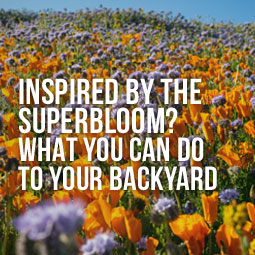
The next time you hear the phrase “drought tolerant plants” and think of a dusty desert landscape, remember this spring’s superbloom.
Wildflowers are native plants, so they are perfectly adapted to their habitat. They can get by just fine, and reproduce as often as necessary to keep their particular flower species going, even when normal conditions are “adverse.” That’s just the way it is. But that doesn’t mean wildflowers don’t appreciate a little help now and then. So when Mother Nature delivers an unexpected rainfall, all those seeds just waiting beneath the surface zip into action.
And, boom! It’s a superbloom!
Innately, the plants know the gift of rain won’t last, so they have to grow quickly and bloom so they can produce a new crop of seeds. Those seeds may also have a longish wait ahead of them. But, for now, we all get to enjoy an amazing sight – hillsides and roadsides covered with a colorful palette of flowers.
What better proof that drought tolerant and stunning can come in the same package! Inspiring, isn’t it?
Bring that inspiration into your own backyard
Just because drought-tolerant is now the mantra for every homeowner, there’s no reason to forgo beauty. You can take a few tips from the superbloom and plant those seeds right in your own landscape. How? Go wild!
You’ve already taken a great leap forward for sustainability, by nixing your natural grass lawn in favor of artificial grass. One thing you’ll never see is a superbloom of weeds in the midst of that lush grass. On the other hand, wildflowers are an ideal companion for that always-pretty (and always drought-tolerant) emerald expanse.
Here are some tips for incorporating wildflowers into your at-home landscape:
- Set aside a plot just for wildflowers because non-native species can often crowd them out.
- Choose varieties that are native to our South Bay Area habitat and also suited to your yard’s conditions. Sun vs. shade, for example.
- You can sometimes find starts in local nurseries, but digging up native plants in the wild to transplant into your yard is a no-no, for two reasons. First of all, they rarely transplant successfully. Second, removing them takes them out of circulation in a location that needs their eco contributions.
- Seeds are a lot easier anyway. Local nurseries and online sources such as American Meadows offer wildflower seeds in combinations for whatever you want. Pick one that includes varieties that will bloom in spring, summer, and fall for the longest show.
- Plant seeds in late fall/early winter, so they won’t sprout till next spring.
It’s all about the seeds
Home gardeners are well-schooled in the art of deadheading. Removing spent blossoms before they can go to seed keeps your garden looking tidy. It also encourages plants to produce more flowers because plants are determined to reproduce! For your wildflower plot, however, it’s hands-off. You want these beauties to go to seed because those seeds will sprout and grow into next year’s display. It’s the circle of life at its simplest and prettiest.
Benefits beyond flowers
S.H.A.R.E. (which stands for Simply Have Areas Reserved for the Environment) reminds us that, without pollinators, we would have little to eat and little chance of ever seeing a breath-taking sight such as the superbloom. Planting wildflowers is an excellent way to invite butterflies, bees, and hummingbirds into your yard. (Did you know that California is home to more than 1600 native bee species?)
Once you’ve planted your wildflower plot, you can let the plants fend for themselves – after all, that’s how they function in the wild. Or you can shower them with a little extra “rainfall” in the spring or during the hottest days of summer, to get an extra burst of flowers.

Source link


ASK QUESTIONS
Sponsored Link
Buy Artificial Grass from Manufacturer Directly at Low Price
High-quality artificial grass for garden, playground, football, field hockey, tennis, putting green, and multi-purpose. Located in China and delivers to the world. Minimal quantity 500m². Click to visit the supplier's official website